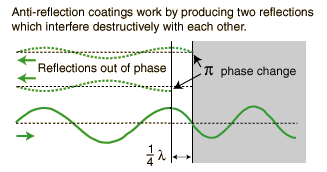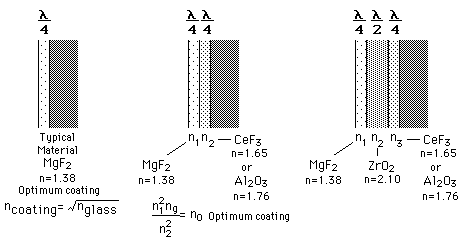Ashwin Sinha
Last Activity: 14 Years ago
Dear Sathya Vinod,
Anti-Reflection Coatings
Thin film anti-reflection coatings greatly reduce the light loss in multi-element lenses by making use of phase changes and the dependence of the reflectivity on index of refraction. A single quarter-wavelength coating of optimum index can eliminate reflection at one wavelength. Multi-layer coatings can reduce the loss over the visible spectrum.
The idea behind anti-reflection coatings is that the creation of a double interface by means of a thin film gives you two reflected waves. If these waves are out of phase, they partially or totally cancel. If the coating is a quarter wavelength thickness and the coating has an index of refraction less that the glass it is coating then the two reflections are 180 degrees out of phase.

| Thin films |
Example calculation |
|
Index
Reflection concepts |
|
|
Multi-Layer Anti-Reflection Coatings
A single layer anti-reflection coating can be made non-reflective only at one wavelength, usually at the middle of the visible. Multiple layers are more effective over the entire visible spectrum.
 |
|
|
|
|
Please feel free to post as many doubts on our discussion forum as you can.
If you find any question Difficult to understand - post it here and we will get you the answer and detailed solution very quickly.
We are all IITians and here to help you in your IIT JEE & AIEEE preparation.
All the best…………
Regards,
Askiitians Expert
Ashwin
Plz. approve my answer by clicking 'Yes' given below, if you loved it......... Plz. Plz. Plz. don't forget to do it.......






